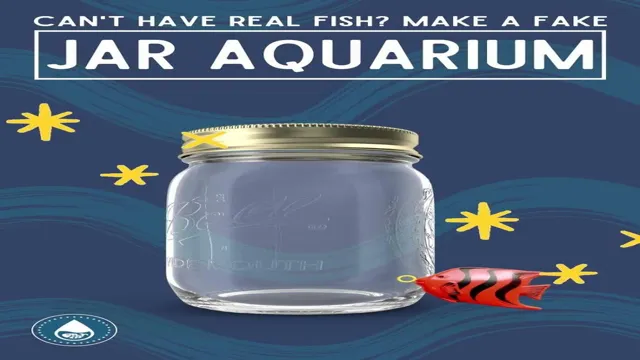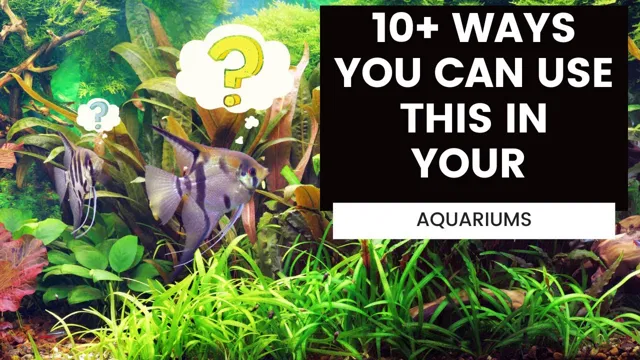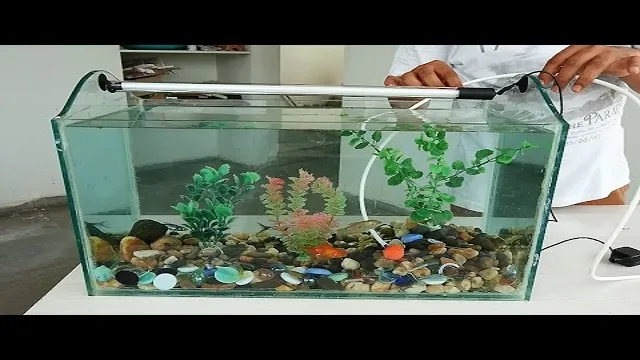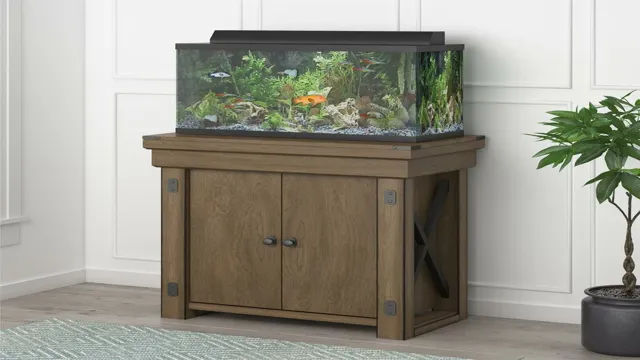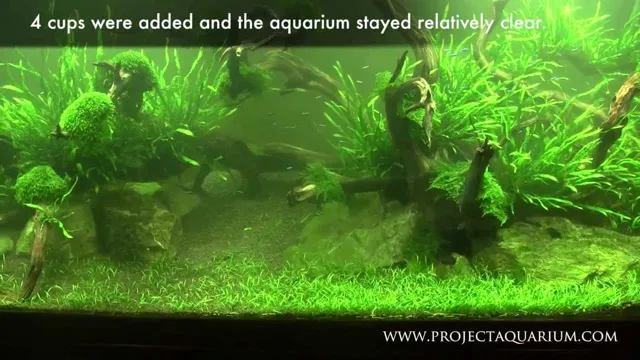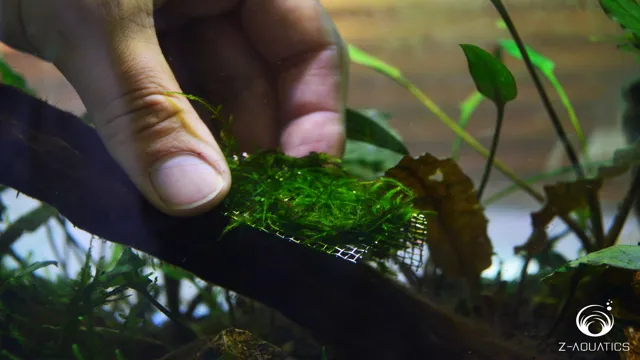Aquariums are a source of peace and tranquility for many of us. However, not everyone has the time or resources to invest in a physical aquarium. This is where quilting comes in! With the right tools and techniques, one can create a beautiful aquatic scene that can be hung on a wall or displayed on a table.
But what good is an aquarium without plants? This is where creating fake aquarium plants for quilting comes into play. Not only can you add visual interest to your quilt, but you can also experiment with a variety of plant species and colors that may not be readily available in your area. Plus, the process of creating these faux plants can be meditative and satisfying in its own right.
So, grab some fabric, thread, and a little bit of creativity, and dive into the world of creating fake aquarium plants for your next quilting project!
Materials Needed
If you’re a quilting enthusiast who loves creating ocean-themed designs, then you may want to learn how to make fake aquarium plants. Luckily, this is a relatively easy craft project that you can make with just a few materials. To make fake aquarium plants for quilting, you will need some colored felt, scissors, thread, and a sewing machine.
Once you have gathered your materials, you can start by cutting your felt into strips, leaving one end slightly tapered like a leaf. You can then stitch the tapered end closed and sew the felt strip onto your quilt. To add some depth to your plants, you can also cut out some felt fronds and attach them to the top of the plant.
With a little creativity and some basic sewing skills, you can create stunning fake aquarium plants for your next quilting project.
Silk Flowers and/or Plastic Plants
If you’re looking to add some greenery to your home decor without worrying about watering and maintaining real plants, silk flowers and plastic plants can be a great option. To get started, you’ll need to gather some materials. First, decide whether you want to use silk flowers or plastic plants.
Silk flowers are generally more realistic and higher quality, but can be more expensive. Plastic plants are more affordable and durable, but may not look as natural. Once you’ve made your choice, you’ll need some containers to display your arrangements in.
These can range from simple pots to more elaborate vases and planters. You’ll also need floral foam or other materials to hold your flowers or plants in place. Finally, consider adding some decorative elements like moss or rocks to complete the look.
With these materials on hand, you can create beautiful floral arrangements and greenery that will last for years to come.
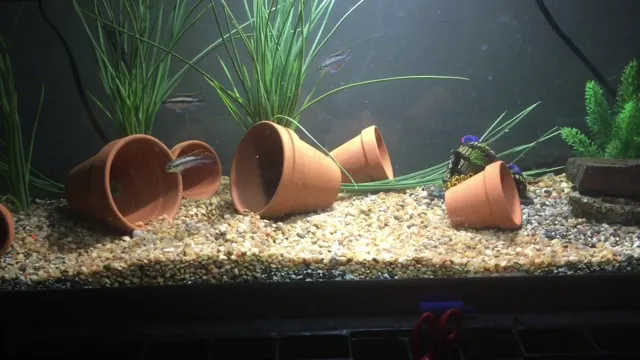
Dye or Paint
When deciding between dye and paint for your crafting project, you’ll need to consider the materials that you’ll need. For dye, you’ll need a bowl, hot water, and the dye itself. Depending on the type of dye, there may be additional materials needed such as vinegar or salt to set the color.
On the other hand, for paint, you’ll need a paintbrush, palette, and the paint colors of your choice. An advantage of using paint is that you have more control over the color and texture, but dye can provide a more transparent look. Additionally, paint can be easier to work with on certain materials such as wood or metal, while dye may work better on fabrics or natural materials.
Ultimately, it comes down to personal preference and the specific project you are working on.
Needle and Thread
When it comes to sewing, having the right materials is essential to ensuring your project turns out just right. For needle and thread work, you’ll need a few key items to get started. First and foremost, you’ll need a selection of needles in various sizes to accommodate different types of fabrics and threads.
Choose needles that are sharp and strong, and consider investing in specialized needles for materials like leather or stretchy fabrics. Next, you’ll need a range of thread in different colors and thicknesses. Opt for high-quality thread that won’t break or fray easily, and make sure you have matching thread for each piece of fabric you’ll be working with.
Finally, you’ll need a pair of sharp scissors or cutting tools to trim your thread and fabric as you work. With these essentials in hand, you’ll be ready to tackle any needle and thread sewing project with confidence. (See Also: How to Attach Plexiglass to Aquarium: A Step-by-Step Guide for Secure Installation)
Preparing the Plants
If you want to make fake aquarium plants for quilting, you’ll need to start by preparing the materials. First off, you can use green felt as your base fabric for the leaves. Cut them into your desired leaf shapes making sure to add extra fabric to the bottom for attaching the stems.
You can then create stems by using green floral wire and twisting it into a plant-like form. To attach the felt leaves to the wire stem, you can use fabric glue and wrap the excess fabric around the stem. Once assembled, make sure to give your fake plants a little extra fluff by opening up the felt to make the leaves look more realistic.
Finally, if you want to add a little more texture, you can use scissors to snip tiny holes into the felt leaves to give a more realistic look of holes and veins. With these simple steps, you’ll have an array of fake aquarium plants to add to your next quilting project in no time!
Dyeing the Flowers and Plants
When it comes to dyeing flowers and plants, the first step is to select the right kind of plant material. Ideally, you should choose fresh and young plants, as they will absorb the dye better. Additionally, it is advisable to pick plants that have a high moisture content, for example, rose petals or hydrangeas.
Next, thoroughly clean the plant material to remove any dirt or debris. Once your plants are clean and dry, prepare a dye solution by mixing water and your chosen dye. Depending on the plant material you are using, you may need to add a mordant, such as vinegar or alum, to help the dye set.
Once you’ve prepared your dye solution, simply place your plant material in the solution and allow it to soak for a few hours. The longer you leave your plant material in the dye solution, the deeper and richer the color will be. After soaking, rinse the plants thoroughly to remove any excess dye and allow them to dry completely.
With the right preparation, you can easily dye your favorite plants and flowers to create beautiful and unique designs.
Painting the Flowers and Plants
When it comes to painting flowers and plants, the first step is preparing them for the painting process. Start by selecting the plants that will be used in the painting and arrange them in a pleasing composition. Next, take the time to study the plants and observe their unique features or characteristics.
This will help you to capture the plants’ essence in your painting. It is also important to consider the lighting and shadows that will be present in the painting. Take note of how the light falls on the plants and the colors that are reflected.
By understanding the plants and their surroundings, you will be able to create a realistic and striking painting. Remember, every plant has a unique story to tell, and by preparing them properly, you can ensure that the painting captures their beauty and essence.
Cutting and Shaping the Plants
In order to get your plants ready for cutting and shaping, there are a few steps you need to take. First, you want to make sure that your plants are healthy and strong. This means watering them regularly, making sure they have enough sunlight and nutrients, and keeping an eye out for any pests or diseases that could harm them.
Once your plants are healthy, you can start thinking about cutting and shaping them. Depending on the type of plant, you may need to use different tools to do this, such as shears, scissors, or a sharp knife. It’s important to be gentle when cutting and shaping your plants, as you don’t want to damage the delicate stems and leaves.
As you work, take breaks to step back and assess the plant from different angles, making sure that you’re achieving the shape and structure you’re looking for. With a little patience and practice, you’ll soon be an expert at cutting and shaping your plants to perfection.
Assembling the Quilt
Have you ever thought about using fake aquarium plants for quilting? It may sound unusual, but it’s a fantastic way to add some texture and interest to your quilt! First, visit your local pet store and grab a few fake plants. You can choose a variety of colors and shapes to match your quilt design. Once you have your plants, wash them with soap and water to remove any chemicals or residues.
Then, trim them to the desired length using a sharp pair of scissors. Arrange the plants on your quilt top, and then use a sewing machine to secure them in place. This technique will add a unique touch to your quilt and will be sure to impress your friends and family. (See Also: How to maintain small fish aquarium: A beginner’s guide to keeping your fish healthy)
Give it a try, and let your creativity take over!
Choosing the Layout
When it comes to assembling a quilt, choosing the layout is an essential step. The layout of your quilt will determine its overall appearance and feel, so it’s important to select one that’s right for you. There are a plethora of layout options to choose from, including horizontal and vertical lines, diagonals, and even custom designs based on a theme or specific pattern.
The key is to find a layout that complements the fabrics and colors used in your quilt and enhances the overall aesthetic. To make the process easier, you can use design software or even sketch your desired layout on paper. Once you settle on the layout, you can begin piecing the quilt blocks together to create your masterpiece.
Sewing the Plants onto the Quilt
When it comes to assembling a quilt, sewing the plants onto the quilt can be a fun and creative way to add some personality and texture. Depending on the type of plant you choose, you can create a variety of looks and colors that will make the quilt stand out. To begin, select the plants you want to use and determine their placement on the quilt.
Once you know where you want them to go, carefully stitch them onto the fabric using a needle and thread. Be sure to use a thread color that complements the plants and fabric to create a cohesive look. Take your time and be mindful of the placement and spacing to ensure the final product looks beautiful and intentional.
When finished, step back and admire your unique and nature-inspired quilt creation!
Tips and Ideas
Looking for a way to add some aquatic charm to your quilting projects? Making fake aquarium plants is a fun and easy way to bring some marine life magic to your fabric creations. Here’s how you can do it: start by choosing the type of plant you want to create and selecting the materials you’ll need. Typically, fake aquarium plants are made using felt or fabric, pipe cleaners, and hot glue.
Use the felt or fabric to create the shape and texture of the plant and twist the pipe cleaners to form the stem. Once the stem is secured to the fabric, use hot glue to adhere any additional details, such as leaves or flowers. Add some color and shading using fabric paints, and your fake aquarium plants are ready to be added to your quilting project.
By adding these charming aquatic embellishments, you’ll bring an enchanting element to any quilt design.
Mix and Match Different Plants
Mix and match different plants to create a unique and beautiful garden. You don’t have to stick with just one type of plant – experiment with different colors, textures, and heights to add interest and dimension to your garden. A good rule of thumb is to choose plants with similar growing requirements, such as sunlight and water needs, so they can thrive together.
When selecting plants, think about both their functional and visual aspects. For example, consider including herbs like basil and thyme in your garden for their culinary uses, as well as their delicious scent. Or, plant taller species like sunflowers or ornamental grasses to create a natural privacy screen.
Another great way to mix and match plants is by incorporating different container and pot sizes. Try grouping together smaller plants in a larger pot, or mix and match different shapes and heights for added visual interest. Don’t be afraid to experiment with different combinations until you find what works best for your garden space.
Overall, a mix and match approach to gardening can be both fun and rewarding. It allows you to create a unique and personalized garden that is perfect for your own tastes and needs. So why not start experimenting today and see what beautiful combinations you can create? Happy gardening!
Adding Additional Embellishments
When it comes to adding additional embellishments to your crafting project, the possibilities are endless. One easy tip is to incorporate buttons or sequins, which can add texture and dimension to your piece. You can also try using lace, ribbon, or trim to create a more delicate or feminine touch.
Adding hand-stitched embroidery or appliques is another fun way to personalize your project and make it truly one-of-a-kind. If you’re looking to add a pop of color, consider using fabric paints or markers to create a bold statement. Another creative idea is to incorporate found objects like beads, shells, or even pieces of driftwood or bark. (See Also: How to Make a Saltwater Aquarium Set: A Comprehensive Guide for Beginners)
Don’t be afraid to experiment with different materials and techniques to find what works best for your project. Remember, the goal is to have fun and let your creativity shine through!
Using Fish Tank Accessories as Inspiration
Fish tank accessories are not only functional but can also serve as inspiration when designing or decorating your fish tank. One tip is to use artificial plants and rocks to create a natural-looking underwater environment. Incorporating different colors, textures, and shapes can add depth and variety to your fish tank.
Another idea is to use themed decorations such as pirate ships or castles to create a unique and visually appealing focal point. You can also use lighting to enhance the overall look of your fish tank and highlight certain accessories or fish. By taking inspiration from fish tank accessories, you can create a beautiful and inviting underwater world for your aquatic pets to thrive in.
Conclusion
In conclusion, creating fake aquarium plants for quilting may seem like a fishy endeavor, but it’s actually quite simple and rewarding. Just grab some fabric, scissors, and a bit of creativity, and you’ll have a colorful aquatic garden to add to your next project. Plus, these plant pals won’t require any feeding, cleaning or maintenance – giving you all the beauty of an underwater paradise without any of the hassle.
So, don’t just fish for compliments on your quilting skills – add some faux flora to your next creation and reel in the praise!”
FAQs
What materials are needed to make fake aquarium plants for quilting?
To make fake aquarium plants for quilting, you will need felt fabric, scissors, thread, a sewing machine, and green and brown colored yarn.
Can I use any kind of yarn to make fake aquarium plants for quilting?
For best results, it is recommended to use a textured, bulky yarn that mimics the look of real plants. Examples include chenille or boucle yarn.
How do I make the leaves for the fake aquarium plants?
To make the leaves, cut the green felt fabric into leaf shapes and sew them onto the yarn stems using a sewing machine. Be sure to vary the size and shape of the leaves for a more natural look.
How do I add texture to the fake aquarium plants?
You can add texture to the plants by unraveling and fraying the ends of the yarn stems. You can also sew on small pieces of fabric or felt to mimic the tendrils and roots of real plants.
Can I wash the fake aquarium plants?
Yes, you can wash them gently in cold water and lay them flat to dry. Be sure to avoid machine washing and drying, as this can damage the fabric and yarn.
How do I attach the fake aquarium plants to the quilt?
You can attach the plants using small, hidden stitches or by using fabric glue. Be sure to arrange them in a natural-looking way and vary the height and placement for a realistic effect.
Can I use the same techniques to make other types of fake plants for quilting?
Yes, you can adapt these techniques to make a variety of fake plants, such as flowers, vines, or trees. Simply vary the colors, shapes, and textures to achieve the desired effect.

